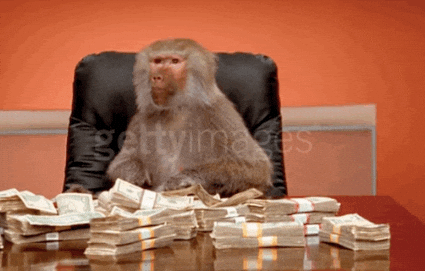If anyone is looking to try out the share market for a little while or start short term trading in the stock market this article is especially for you.
Long term investing is the approach we grew up watching our fathers take. We learnt how to invest by osmosis.
Fahd traded for 6 months during his university days and decided it wasn’t for him, before returning to it when he changed careers to investment banking. Why? He now understood that patience was required. 6 months wasn’t enough.

For the last 15 years, we have taken a long term approach to invest money in all facets of our lives including the stock market.
This strategy is also called ‘buy and hold’, where you buy stocks, index funds or REITs and hold them for an indefinite amount of time.
REIT – Real Estate Investment Trust; a company that owns, operates, or finances income producing properties.
In this article, we highlight why the long term investing approach is always the safest and best way to invest in the market.
Reason 1 – Compounding
The difference between trading and investing is that trading is typically based on knee jerk reactions whereas investing allows your money the time to make a profit and accumulate wealth over time.
This is where you can see the 8th wonder of the world take effect.
8th wonder of the world?
E = mc2 pales in comparison to compounding.

“Compound interest is the eighth wonder of the world. He who understands it, earns it … he who doesn’t … pays it.”
Albert Einstein
Interest to us isn’t the modern concept of interest. Rather it’s the ‘interest’ in the company in the form of our capital invested in it.
The reason this strategy will never be beaten by traders is that long term investing allows your capital to accumulate and gain profits over time.
Over time the capital you invested is going to earn compounding returns (a.k.a. compounding interests) and the money experiences exponential and accumulative growth.
That right there is the key reason we beat short term trading. Compounding is really only possible with time.
Over time the capital you invested is going to earn compounding returns (a.k.a. compounding interests) and the money experiences exponential and accumulative growth in comparison to short term trades. Or something like that.
Reason 2 – Fees and taxes
If you’re a long term trader you will only ever pay one fee (brokerage or transaction cost) for the life of your purchase if you buy and forget like us.
When I say forget, we have absolute confidence in the long term future of every company we own shares in and therefore we are mostly immune to the herd mindset the market is rife with.
You also pay fewer taxes in Australia as a long term investor. The Capital Gains Tax (CGT) only applies to capital gains on shares or units when a CGT event happens, such as when you sell them (unless you acquired them before CGT started on 20 September 1985).
However, if you’re a trader, you have to pay your broker fees every time you buy and sell shares. Also if you’re selling your shares to make a profit, you pay more taxes on that profit as a short term trader.
These fees and charges that you pay is money that could otherwise have been accumulating a return of 5-12% every year.
These fees and taxes equal money that could otherwise have been accumulating at a rate of 5-12% or more and compounding. Money that you pay in fees and taxes is money that you cannot put to work for you.
If you’re a trader, you are also extremely vulnerable to short term corrections and recessions, especially if you are are new to investing.
However, if you apply a buy and hold strategy, short term turbulence doesn’t really matter because you can hold the vision you had when you invested in the company.
When a company we own shares in swings downward, and all our analysis and research still aligns with a bright future, we buy more shares of that company at a cheaper price. We cover this in more detail in our secret to buying at the bottom article.
This long term mindset allows us to sleep well at night and ignore the noise that is generated by the market.
Reason 3 – What history tells us
As a rule of thumb if you hold your money over ten years in an index fund or blue-chip stock, historically there is almost ZERO chance of you losing money. This is true, despite share market crashes, financial crises and world events.
From 1988 (that’s when Fahd was born) to 2020 the S&P/ASX 200 Index has risen from 1200 points to 5755 points.
That’s what happened over 32 years. Fahd and I have only been investing for less than half that time, 15 years.
Over 3 decades, the world has witnessed over 8 financial crises.
That’s 1 every 4 years on average.
Despite the crises, in the melting pot of human ingenuity, hope, greed and fear the S&P/ASX 200 index continued to rise from 1251 points to 5755 points.
The reason the current COVID crisis is affecting us is because we are smack bang in the middle of it and a lot of us have transitioned from being dependents and having food put on our tables to being the breadwinners ourselves and providing food for our dependents.
Below is a list of the most prominent crises that we remember and how the S&P/ASX 200 was affected.
[table id=7 /]
What we can observe from the above table, is that even though the market has experienced some crashes in the long term, the market always corrects itself and we establish new highs and new lows.
Let us take for example a popular ETF (ASX: VAS), I am only using them as an example as I would not invest in them due to them not passing our framework for ethical screening.
ETFs are defined as exchange-traded funds, they are traded on major stock exchanges, like the New York Stock Exchange, Nasdaq and ASX. You can buy and sell shares in an ETF through your brokerage account. An ETF is a collection of tens, hundreds, or sometimes thousands of stocks and bonds in a single fund. It’s targeted for people who want less risk and don’t want to spend time researching stocks to select.
Let us also take a company we have researched, Medical Developments International Limited, ASX:MVP.
Story time. It’s 2010. We have two investors, Amina and Zara. Both have a $1000 to invest and were told that once invested, they couldn’t touch it again for 10 years.
Amina is fresh out of high school and chose to put the $1000 in ASX:VAS (Vanguard ETF) after learning that an index is less risk and she doesn’t need to do any further research.
Zara is a single mother who did her research through various sources and put her $1000 in ASX: MVP (Medical Developments International).
They purchase the shares through NABtrade and pay a broker transaction fee of $14.95 on the 31st May 2010.
Fast forward. Current day 2020. Actual prices for ASX:VAS and ASX:MVP used in the table below.
[table id=8 /]
Zara made a profit of 3,200 %. That’s 33 times her initial investment!

If an example of 3,200% return doesn’t convince you of the benefits of long term value investing, nothing will.
Granted, not every company will perform like the one used here. It takes experience, skill and painstaking research to find gems such as this.
Our current portfolio has companies that have already done 100% to 300% returns in a few months.
At Tabarruk, we never invest in Index Funds or ETFs. We aim to make sure our money is working as hard as Zara made hers work. Money compounding in quality companies that we pick across sectors will always beat the net averaging out effect in ETFs or index funds.
Every stock we purchase has to pass through the Tabarruk Framework and Screening™ process.
It is extremely important to know that in the last 10 years, the market has come out of a recession, and also undergone corrections (small dips).
Today we’re smack bang in the middle of a recession due to #covid.
But quality always prevails and corrects over time, every time.
If Australia were to go through a deep depression, we’re all going to be just fine if we hold quality company shares.
The question to ask yourself is, what quality of your stocks would you rather own?
A portfolio is only made up of two types of stocks:
- Value
- Junk
I could also compare the above scenario of Zara and Amina by adding the short term day trader, Tarek.
Let’s say Tarek trades every other day for 10 years.
Half of his transactions are buys and the other half are sells.
That’s 255 working days for 5 years = 1,275 days
2 trades a day is 1,275 x 2 = 2,550 trades
Let’s use SelfWealth as the broker, where transaction fees are $10 per trade.
2,550 x $10 = $ 25,000 in fees.

Transaction fees alone! The cost of being a short term trader.
Even if we say Tarek traded half as often, 2-3 times a week, you’re looking at $10,000 – $12,000 in fees.
You can also safely assume that Tarek would have sold plenty of his shares within 12 months of owning them. Capital gains tax will eat a chunk of any profits.
I’m not going to bother with guesstimating what Tarek would actually pocket after all expenses over 10 years.
I will tell you one thing. The time needed to watch the market during open times, 10am – 4pm means he’s not doing much else, let alone a day job.
Also consider adding in the following:
- Company selection
- Volatility of market
- Initial investment of $1000
- Fear, greed, probability of success
- Time to research number of different companies on any given day
How many companies and transactions do you think Tarek would have got right? Even with some MVP’s sprinkled in there, Tarek isn’t buying and holding shares for 10 years hence no compounding of profits.
The stress, the control of emotions and self-awareness of one’s own psychology needed to be consistently successful, is something very few could learn to be masters at.
Even then, I seriously doubt any of them would do a profit of 3,200% over 10 years.
Some of the best short term traders we know, have a win rate (the number of times they make any profit) is just over 50%. Even with a win rate of 50-55%, smaller wins may not make up for a few big losses. Breaking even might be an outside chance.
So, if you’re going to start investing, do it in a way that makes your gains accumulate.
Bonus Wins
If your company offers you shares for your dividends, sign up for it by checking if the company has a dividend reinvestment plan. If you are wondering how to do this, feel free to contact us and we can help you out.
A dividend is the distribution of a portion of the company’s earnings, decided and managed by the company’s board of directors, and paid to a class of its shareholders. Common shareholders of dividend-paying companies are typically eligible as long as they own the stock by the ex-dividend date. Dividends may be paid out as cash or in the form of additional stock.
Accumulative and exponential growth is the best thing about investing. It’s not about just a fixed flat 5-7% every year but the accumulation effect because it grows at a certain percentage. The more money you have (in the form of returns) the more money it grows by every year.

If I had the option of leaving you with only one sentence to remember out of this whole article it would be the following:
“You can’t time the market, but you can spend time in the market.”
The longer the time your money spends in the market, the bigger the potential scale of your return.
I get that it is sometimes hard to buy and hold on, to weather turbulence. You may get frustrated, nervous or scared.
By selecting quality investments and understanding that holding with patience and conviction is where the real growth occurs, you will give yourself the platform to have life-changing success.
The successful investors often do the opposite of what the ‘herd’ does, they let their money work over long periods and the accumulation and dividends will more or less guarantee growth.
 moin
moin